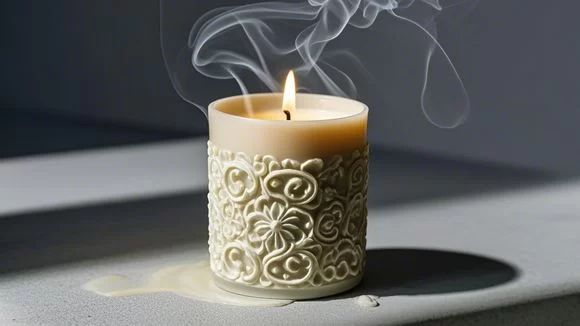Are Scented Candles Harmful to the Human Body? What You Need to Know
Scented candles have long been a popular choice for adding fragrance and ambiance to homes, creating a calming atmosphere, and enhancing relaxation. However, in recent years, there has been growing concern about whether these candles might be harmful to your health. With increased awareness of air quality and indoor pollutants, many people are wondering: Are scented candles harmful to the human body?
In this article, we will explore the potential health risks of scented candles, the ingredients that make them both enjoyable and potentially harmful, and how you can safely enjoy the ambiance without compromising your health.
- What Are the Health Risks of Scented Candles?
- What Ingredients Are in Scented Candles?
- How to Make Scented Candles Safer
- Choosing Safe Scented Candles
- Eco-Friendly Candles: A Healthier Alternative
1. What Are the Health Risks of Scented Candles?
While scented candles can provide a pleasant atmosphere, there are some potential risks associated with their use, especially when burned frequently or in poorly ventilated areas. The main health concerns related to scented candles include:
- Indoor Air Pollution: Scented candles, particularly those made from paraffin wax, can release volatile organic compounds (VOCs) into the air. VOCs are chemicals that can contribute to indoor air pollution, which may lead to headaches, dizziness, or respiratory issues.
- Particulate Matter: Burning candles can release tiny particles into the air. When inhaled, these particles can irritate the respiratory system, especially in people with asthma or other breathing conditions.
- Fragrance Sensitivity: Some people may have allergic reactions or sensitivities to the synthetic fragrances used in many candles. Symptoms can include sneezing, skin irritation, or headaches.
- Potential Toxicity of Wicks: In some candles, the wicks may contain harmful materials like lead, though this is less common today. Always check for wicks labeled "lead-free" to avoid this issue.
2. What Ingredients Are in Scented Candles?
The ingredients in scented candles vary depending on the type of candle and the manufacturer. However, many scented candles contain the following key components:
- Wax: Most candles are made from wax, and the most common types are paraffin wax, soy wax, and beeswax. Paraffin wax is a by-product of petroleum and is often used in cheaper candles. Soy and beeswax are natural and considered safer alternatives.
- Fragrance Oils: Scented candles rely on fragrance oils to produce their signature scents. These oils can be synthetic or natural. Synthetic fragrances may contain potentially harmful chemicals, while natural essential oils are a safer choice.
- Wicks: Wicks are usually made from cotton or wood, though older candles might have lead-core wicks (no longer common). The material used for the wick affects the burn quality and the amount of toxins released.
3. How to Make Scented Candles Safer
If you love burning scented candles but are concerned about potential health risks, there are a few steps you can take to reduce the dangers:
- Ventilate Your Space: Always burn candles in well-ventilated areas to prevent the buildup of harmful VOCs and particulate matter. Open windows or use a fan to circulate the air.
- Choose Natural Wax Candles: Opt for candles made from natural waxes like soy or beeswax. These types of wax burn cleaner and produce fewer harmful emissions than paraffin wax candles.
- Use Candles with Essential Oils: Whenever possible, choose candles that use natural essential oils rather than synthetic fragrance oils. Essential oils are less likely to cause allergic reactions and are generally safer to inhale.
- Trim the Wick: Trim the wick to about 1/4 inch before lighting. This helps prevent excessive soot production and ensures a cleaner burn.
- Avoid Overheating the Wax: Do not allow candles to burn for longer than recommended. Prolonged burning can lead to increased production of soot and other harmful chemicals.
4. Choosing Safe Scented Candles
When choosing scented candles, consider the following tips to ensure you’re purchasing safe, non-toxic products:
- Look for Natural Wax Options: Candles made from natural waxes like soy, beeswax, or palm are typically better for your health and the environment. Avoid candles made from paraffin wax, which may release harmful chemicals when burned.
- Check the Fragrance: Opt for candles that use natural essential oils for fragrance rather than synthetic scents. Essential oils not only smell better, but they are also less likely to cause respiratory issues.
- Choose Lead-Free Wicks: Always choose candles with lead-free wicks. Modern candles use cotton or wood wicks, which are safe and efficient.
- Consider Eco-Friendly Brands: Look for brands that prioritize sustainability and use non-toxic, eco-friendly ingredients in their products. Many eco-conscious brands offer safe and healthy options for candle lovers.
5. Eco-Friendly Candles: A Healthier Alternative
Eco-friendly candles are not only better for the planet, but they are also a healthier alternative to traditional scented candles. By choosing candles made from natural waxes like soy or beeswax, and opting for pure essential oils, you can significantly reduce your exposure to harmful chemicals. Many eco-friendly candles are also produced by companies that are committed to sustainability, ensuring that your purchases are contributing to a healthier world.
If you’re looking for high-quality, eco-friendly candles that are safe for your health, check out Scent Snob for a curated selection of clean-burning, non-toxic options.


0 comments